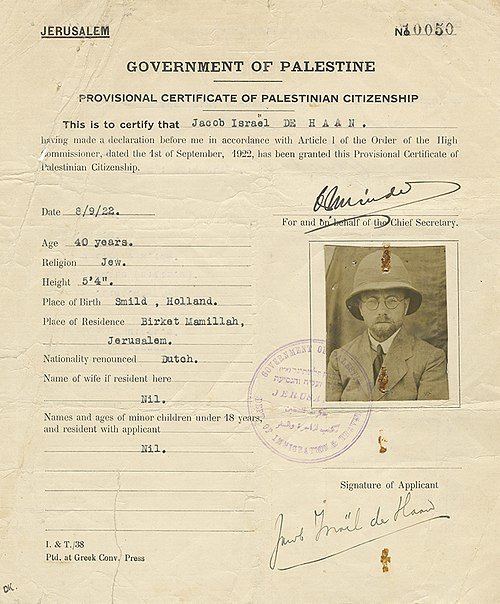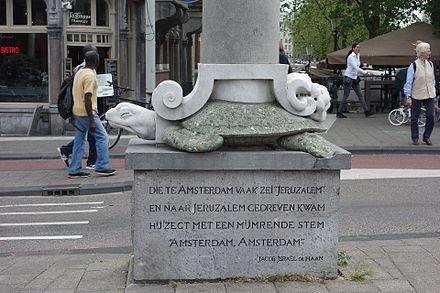Dr. Jacob Israel de Haan: A Controversial Figure in the Early Zionist Movement
Dr. Jacob Israel de Haan, born on December 31, 1881, in the village of Smilde, located in the northeastern region of the Netherlands, was a multifaceted personality of his time. He was a jurist, journalist, poet, and writer who primarily wrote in Dutch. As a Dutch-born Jew, he was an active Zionist who initially championed the Zionist cause but later turned against the movement. He ultimately became the victim of what is considered the first political assassination in modern Israel.
Early Life and Education
De Haan was born into a religious family with 18 siblings. His father, Isaac Isaac de Haan, was a cantor known for his fervent religious devotion. However, due to his strong character, Isaac frequently clashed with the congregations he served, eventually settling in Zaandam, near Amsterdam.
Jacob's sister, Carry van Bruggen, was a prolific writer, known for her book "The Little House Next Door," which depicted their family home. De Haan himself left the faith at a young age and integrated into Dutch society. In his youth, he attended a teacher training college and later joined the Dutch Social-Democratic movement as a Marxist in 1903. He quickly rose to prominence within the movement and was known for his legal expertise, journalism, and poetry. He was fluent in several languages.
Personal Life and Ideological Shifts
De Haan was a homosexual, a fact he did not openly disclose but revealed in his writings, notably in his 1904 book "Canals." In 1907, he married Johanna van Maarseveen, a Christian physician nine years his senior.
In 1912, he traveled to the Russian Empire to investigate the conditions in its prisons. Upon his return, he published "Russian Prisons," detailing the inhumane conditions he had witnessed. However, upon returning from Russia, he underwent another ideological transformation, renouncing Marxism and returning to Judaism. He later joined the religious Zionist movement.
In 1916, he defended his doctoral thesis, which delved into linguistic and semantic aspects of law and justice, at the University of Amsterdam. After World War I, he decided to immigrate to Palestine in 1919, expressing his desire to contribute to the Zionist cause.
However, he quickly realized that neither the Zionist institutions nor the Hebrew University, then in its early stages of development, were interested in his services. He even unsuccessfully sought the position of Dutch consul in Jerusalem in 1920. In 1921, he became the head of the Sephardic Talmud Torah "Dorshei Zion."
Shift Towards Ultra-Orthodoxy and Opposition to Zionism
Frustrated and disheartened, De Haan underwent another transformation and joined the fervently Orthodox circles of the Jewish community. He became close to Rabbi Yosef Chaim Sonnenfeld, the leader of the Ultra-Orthodox community.
During his time in Jerusalem, De Haan continued his relationships with men, including some he met among the Arab youths of Jerusalem. However, he concealed this aspect of his life from his Ultra-Orthodox associates. This facet of his life was reflected in his book of poetry, "The Squares," published shortly before his death in 1924.
At the same time, he earned a living through his writings, contributing articles to the popular Dutch newspaper "Algemeen Handelsblad," in which he described life in Palestine. He also worked as a lecturer in law at the School of Law and Economics of the British Mandate in Palestine.
Political Activity in Service of the Ultra-Orthodox Community
De Haan offered his legal skills to the Ultra-Orthodox community, translating their documents into English and providing legal counsel to the Agudat Yisrael organization. Over time, he became the official political representative of the organization without financial compensation.
De Haan was an exceptional figure within the Ultra-Orthodox community, as a European-educated modern Jew. He admired Rabbi Yosef Chaim Sonnenfeld, under whose blessing he acted, but soon became an extremist figure among the Ultra-Orthodox circles.
He tirelessly fought against the Zionist settlement movement, accusing its leaders of being "dangerous individuals whose aspirations would incite the Arabs against us." He likened the behavior of the Zionists toward the Arabs to the anti-Semitism directed at Jews in Europe.
De Haan leveraged his diplomatic and personal connections to publicize his views in the European press, including publications such as the London-based "Daily Express" and the Dutch "Nederlandsch-Israëlietisch Weekblad."
In 1923, Eli Hertz, the first Baron Beaverbrook, owner of the "Daily Express," visited Palestine. De Haan met him, and following their meeting, Lord Beaverbrook allowed him to publish his anti-Zionist articles in his newspaper. De Haan initiated a campaign against the taxes imposed by the British High Commissioner, advocating for the cancellation of the British Mandate over Palestine.
Opposition to Zionism and Diplomatic Efforts
De Haan consistently criticized Zionism and its leaders, portraying Rabbi Abraham Isaac Kook and other religious Zionist leaders as criminals. He waged an aggressive campaign against Rabbi Kook, filing numerous legal complaints and accusations against him, including allegations of forging a certificate, for which De Haan was ordered to pay court costs and lawyer fees.
In one court proceeding, he insulted the judge with mockery and derision and frequently switched between languages (English, Arabic, and Hebrew) to harass the court. His adversaries also accused him of trying to foment conflict between the Jewish and Arab communities.
He maintained regular contact with the Arab leadership and even developed a friendship with Emir Abdullah of Transjordan. De Haan sought to establish an agreement with the Arab leadership that would not infringe on the rights of the Ultra-Orthodox Jewish community in Palestine. He proposed that Jews could live freely in Arab countries, including Palestine, in exchange for relinquishing political rights in the land.
De Haan organized a religious delegation led by Rabbi Yosef Chaim Sonnenfeld, which departed for Jordan on June 23, 1923, to meet with Emir Abdullah (later King Abdullah I of Jordan). They also had a formal dinner with the British High Commissioner, Herbert Samuel.
During these meetings, the delegation emphasized the autonomy of Agudat Yisrael, which represented many Jews worldwide, and the importance of collaboration among all residents for the development of the land. During these discussions, De Haan secured a substantial sum from King Abdullah for the benefit of the Ultra-Orthodox community.
Threats and Assassination
In May 1923, De Haan received a threatening letter warning him to leave Palestine by May 24.
De Haan was scheduled to leave for London on July 1, 1924, as part of a delegation representing the Ultra-Orthodox community to oppose a law granting status to Jewish communities in Palestine. It was rumored that he intended to work against the Balfour Declaration as well, although he denied any such plans after a previous meeting had raised suspicions.
On June 30, 1924, as he walked down Jaffa Street in Jerusalem after the afternoon prayer at the synagogue located within the courtyard of Shaare Zedek Hospital, he was shot three times with a revolver. The assassin escaped, and the identity of the killer remains disputed.
Legacy and Controversy
De Haan's life and actions continue to be a subject of debate and controversy. Some view him as a tragic figure who struggled with his identity and beliefs, while others see him as a turncoat who betrayed the Zionist cause and aligned himself with its adversaries. His assassination remains unsolved, and various theories about who was responsible persist. In the end, De Haan's complex life and the circumstances surrounding his death reflect the multifaceted nature of the early Zionist movement and the challenges faced by Jews in British Mandate Palestine.
- יעקב ישראל דה האןhe.wikipedia.org










